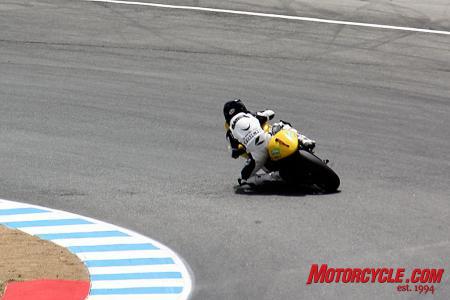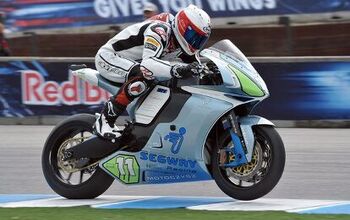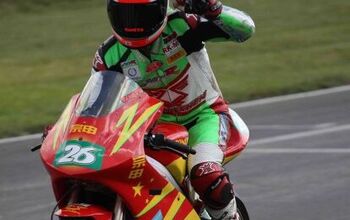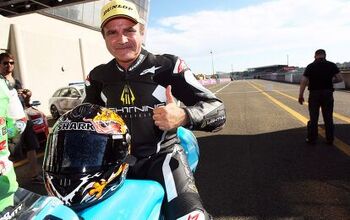2010 FIM E-Power Race at Laguna Seca
In what was essentially a race between electric motorcycle prototypes, last Sunday Michael Czysz narrowly beat Michael Barnes at the FIM e-Power competition at Mazda Raceway Laguna Seca, after Barnes essentially ran out of power at the very end of the 9-lap race.
Third place for the 8-bike field was taken without contest by Thijs De Ridder of Belgium, while a battle for fourth through sixth places ensued among Thomas Betti (Italy), Matthias Himmelmann (Germany), and Luciano Betti (Italy). Seventh and eighth were taken by American Mike Hannas, and Christian Amendt of Germany.
A total of 12 teams had come hoping to compete, but some failed under FIM guidelines to qualify on Saturday, and a couple could not start due to equipment failure. The Proto Moto team (U.S.) had qualified, but its motor broke. And the much-anticipated Empulse RR, from U.S.-based Brammo, never made it onto the track, having suffered an undisclosed component failure in prior testing.
As implied in the opening paragraph, electric motorcycle racing is still experimental. It was only a year and one month ago when the first Isle of Man TTXGP ran, and Sunday’s race of single-speed e-bikes was the inaugural FIM-sanctioned event at Laguna Seca.
The sport is still finding its legs; proving what works and what doesn’t, while fans decide whether they’re interested, or not.
Accordingly, the crowd of 51,000 – most of whom had come to watch MotoGP and AMA Pro races – witnessed an exceptionally broad variety of competitiveness in this, the only electric motorcycle race of the weekend.
Top speeds recorded for Sunday’s e-bike race ranged from 116.6 mph down to 75.7 mph, and best lap times on the 11-turn, 2.238-mile circuit varied from 1:44:496 to 2:04.837.
The e-bike disparity would have been even greater if qualification was not required by the FIM, as is the case in the free-for-all TTXGP series.
While in a sense it’s true also for petrol-powered teams, the e-bike race was particularly a match between enterprises attempting to harness emerging technology, and doing so with widely varying budgets, levels of engineering proficiency and expertise.
At this week’s shake-out session, the favorites for first place among the international field were two American teams – two others, that is, than the still-enigmatic Brammo team.
Trap speeds recorded by the MotoCzysz and Lighting machines were competitive with each other, and they blazed 20-25 mph faster and lapped several seconds quicker than the Belgian who took the third step on the podium.
The resplendent white saddle of the seemingly advanced e-bike even matched the white leather captain’s chairs inside the RV, and together with uniformed workers and a red-rubber floor on which to work under a black canopy, the entire ensemble was quite dashing.
In contrast, Richard Hatfield’s unpresumptuous Lightning team worked unceremoniously out of the back of a van on what looked to be a much less refined machine.
This “yellow banana,” as the announcer began calling it on Saturday, has nevertheless been consistently asserting itself with a second place and a pair of first place finishes in the TTXGP series.
Until Laguna Seca, Barnes had never faced Czysz, but whether or not the Lightning team spent as much money to create a glossy impression, Barnes didn’t do very badly at all.
In fact, while Czysz is believed to have had more reserve battery capacity – thus potentially more performance left unseen – and his machine is infinitely more wow-inducing to behold, this race arguably belonged to Barnes.
This was true despite the fact that both had to contend with problems unique to e-bikes – one at the beginning of the race, the other at the end.
In the case of Czysz, although he’d qualified closely behind Barnes, a malfunction off the line Sunday immediately cost him five seconds. In Barnes’ case, control algorithms designed to protect his 11.0 kWh battery from deep discharge cost him even more.
It is true that the MotoCzysz malfunction essentially control-alt-deleted 5 seconds from his game plan. But by lap 2, he was ahead of De Ridder, and with a clear path in front of him. Even so, Czysz did nothing to prevent the veteran AMA pro from running away from him the old fashioned way – by being faster.
With a 5.068-second lead gifted to him on lap one, Barnes earned 1.5 seconds more on lap two, 0.7 on lap three, and 2.5 seconds on lap four.
Going into lap five, Barnes was ahead by nearly 10 seconds, and with four laps to go, he kept cruising but with less urgency, needing only to maintain his pace.
He and Czysz remained within a second per lap through laps five, six and seven, but somewhere along the line his bike’s computer started to reduce the power to its otherwise class-leading General Motors EV-1 motor.
By the end of the last lap, the Lightning was limping so slowly, Czysz easily closed a several-second gap in the final few hundred yards, beating Barnes by 1.238 seconds. Barnes ran out of juice entirely on the cool-down lap.
According to Jeff Major, the electrical engineer working on the Lightning race bike, the team was given only 30 minutes notice of two sighting/warm-up laps that had to be run in addition to the 9-lap race itself.
He said they’d budgeted just enough power for nine, and had not accounted for the extra demand. What they could have done about it even if they’d been told sooner, he said, is unknown.
Power-to-weight ratio
Czysz would not comment on how much his bike weighs, how much battery power he has, or what kind of motor he runs.
We do know it weighs more than 515 lbs and uses some form of lithium-ion batteries driving some form of liquid-cooled AC motor. Knowledgeable competitors speculate he has at least 12 kWh, if not more.
Czysz, with a lean, athletic build is about 6-feet tall, and maybe 20-40 lbs heavier than the several-inch-shorter, lightly-built Barnes.
Barnes, however, must contend with a bike that weighs in excess of 600 lbs, which more than makes up the difference in rider/bike weight packages. Further, his bike lacked cornering clearance at the beginning of the season, so the Lightning team worked with Race Tech suspension services to raise the bike as high as possible.
Barnes said he has to be creative in line selection, such as a rider would on a 125cc 2-stroke – albeit without the extreme lean angles – and would not want more weight added to the “heavy” machine, such as more batteries would give.
“But we’re scared to move up too fast untested. You know on race day you don’t take big bites,” Czysz said, “So we looked at what they had, and we looked at what we’re doing, and we made a calculated decision. And, you know, obviously we cut it very close.”
These statements practically confirm Barnes’ post-race feeling that Czysz was playing a cool hand that nearly bit him, but was ultimately counting on Barnes running out of power.
“He had his own strategy. My strategy was to take off and try to build a lead,” Barnes said. “His strategy was most likely to conserve and get me at the end.”
But, we replied, he couldn’t have caught you if you didn’t run out of juice.
“He kinda knew I was going to run out of juice,” Barnes stated.
How did he know that?
“I don’t know,” Barnes replied.
You think he knew that?
“I think he knew that,” Barnes said.
That’s speculation. But that’s your gut, we said rhetorically.
“That’s my gut,” Barnes confirmed.
Wild cardAs mentioned, the other U.S. team expected to do something significant at Laguna – Brammo – did not get to run due to a proprietary part failure while testing at Thunderhill Raceway Park.
But don’t dismiss the Empulse RR just yet, say Brammo’s people.
Brammo’s lead designer, Brian Wissman says his 472-lb machine has a water-cooled brushless AC motor, and 12.5 kWh in power from batteries which Brammo says are possibly the best available.
According to Brammo’s Lead Engineer, Aaron Bland, the motor has been dyno’d at over 80 hp (over 60 kW) at the rear wheel. It was geared to hit the 120-mph range the MotoCzysz and Lightning bikes were doing, and Bland said the bike has cornering clearance equal to a CBR1000RR. But bench racing will only get you so far, he added.
“This would have been a good track for us,” Bland said, while conceding, “It’s too close to call just by observation of the specs.”
Even so, we would have liked to have seen that bike piloted by the 150-or-so pound, former AMA national champion Aaron Gobert. Our bet is that Brammo would have taken second place, if not first.
Bland said they have plans to cut another 10-20 lbs, and we’ll be looking forward to more news on this machine.
According to Adrian Stewart, Brammo’s director of sales and marketing, the bike is tentatively scheduled to show how competitive it can be in the FIM e-Power series Aug. 11, at Magny-Cours in France, or Aug 26, at Imola in Italy, or possibly in both races.
“Gobert may well be our rider,” Stewart said, “Nothing confirmed at this time.”
In sum
For now much of the glory belongs to MotoCzysz, but Lightning’s Richard Hatfield fielded a very competitive machine at Mazda Raceway Laguna Seca – and his team appears to be doing it with a much smaller budget aimed first toward results.
At the rate things are going, it appears the dominant e-bike teams in the world are all American, but who knows who else may come and upset the balance of power?
This and many other questions remain that only time will answer. For example: Will a new battery technology replace lithium ion? How much more development is left in existing technology? That is, how much lighter and more powerful can these machines get? When will transmissions be seen as feasible to expand existing power? And ultimately, how close in performance to petrol-powered machines can they become?
We’ll be watching these and all other issues, and report as we find out.
Related Reading
Electric Motorcycles Primer
2011 Brammo Empulse Preview
Roehr Launches Electric Sportbikes
MotoCzysz to Race 2010 TT Zero
Isle of Man TT Splits With TTXGP
Electric Superbike Unveiled at SEMA
TTXGP Disappointed With FIM
Brammo’s Enertia Electric Bike Off to Washington DC [Video]
2010 Zero S and DS Review
Jeremy McWilliams Rides the MotoCzysc C1
More by Jeff Cobb









































Comments
Join the conversation